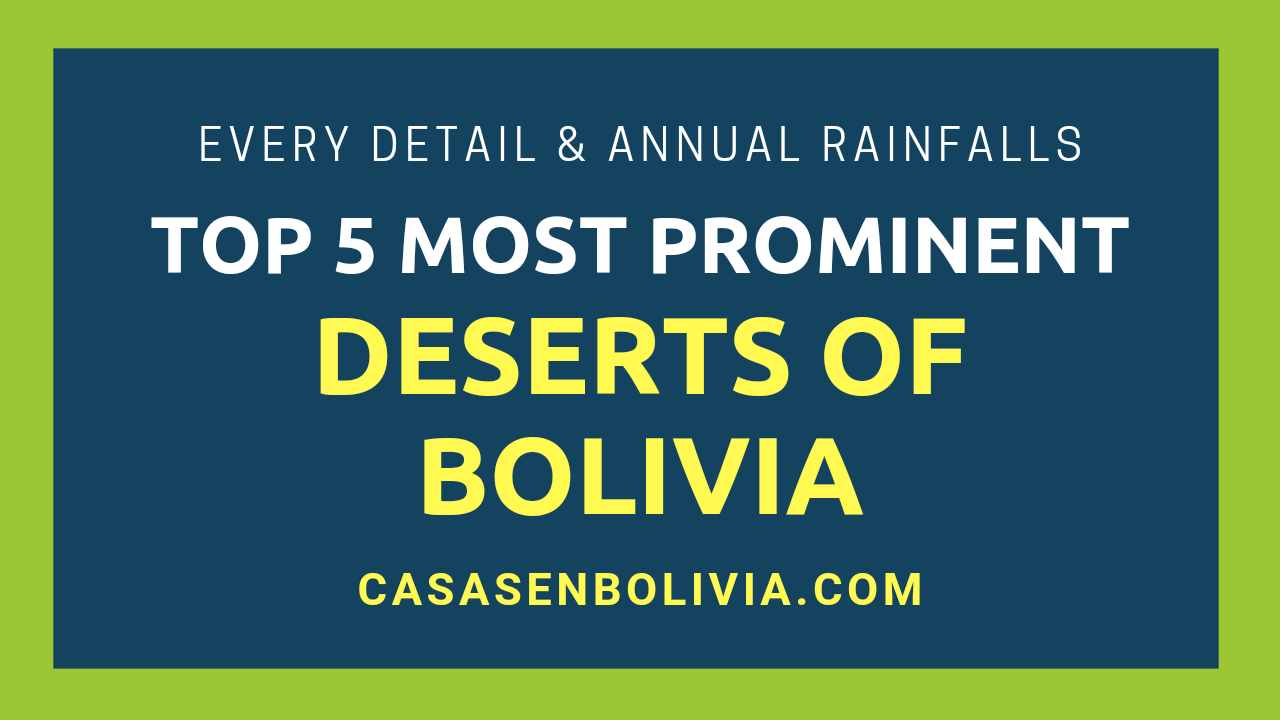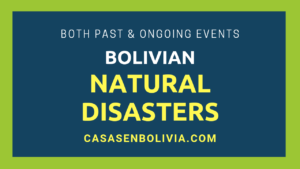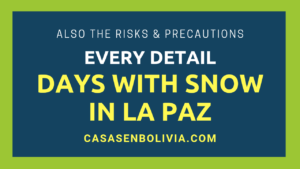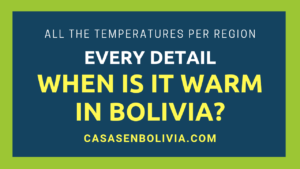Last Updated on February 15, 2025
Bolivia doesn’t have a large area that qualifies as a true desert. In fact, less than 1% of Bolivian territory meets the criteria. However, deserts *do* exist in the country, and they are also highly valued tourist attractions, as you’ll see. Additionally, there are quite arid regions in the country that are worth mentioning.
Bolivia’s five most significant deserts are: 1) Siloli Desert, 2) Dali Desert, 3) Sol De Mañana Desert, 4) Uyuni Salt Flat, and 5) Coipasa Salt Flat. The annual rainfall in these locations ranges from 65mm to 300mm. There are also the Altiplano and Gran Chaco regions, which are very arid and extensive.
Here, we’ll discuss the five most important deserts in Bolivia, including their annual rainfall, locations, and standout features, among other details. You’ll also learn more about both the Altiplano and Gran Chaco regions, which can also be quite arid. We are Bolivian real estate experts (website).
How Much of Bolivia is a True Desert?
A) Less Than 1% of Bolivia is Actually True Desert
Only a tiny portion of Bolivia is a true desert—small areas where there’s almost no rainfall throughout the year. These are extremely arid lands with virtually no flora or fauna. Furthermore, all the desert areas within the country are located in a very specific region: *the southwestern part of Bolivia, within the Potosí department*.
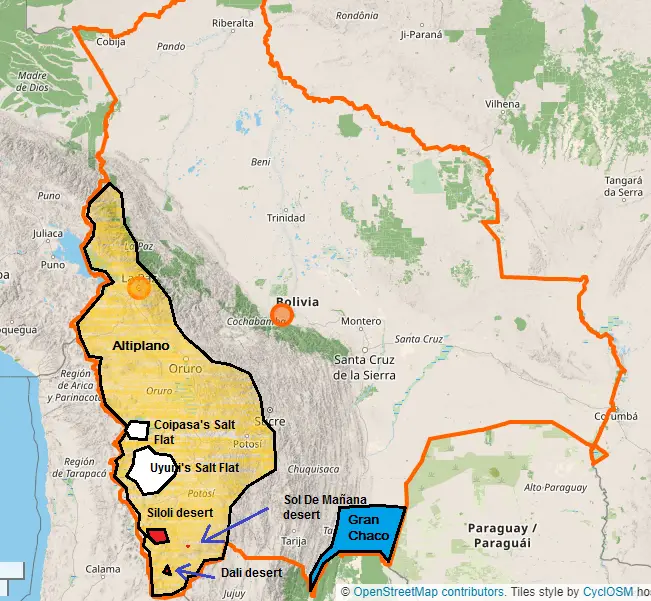
This 1% of Bolivian territory consists of several closely located deserts, all in the western part of the country, in the region known as the Altiplano. These extremely dry places include:
- The Siloli Desert
- The Salvador Dalí Desert
- The Sol De Mañana Desert
- The Uyuni Salt Flat
- The Coipasa Salt Flat
These locations typically have between 65mm and 300mm of annual precipitation and also experience freezing temperatures at night.
We’ll discuss all these deserts and their details in a later section.
B) 27% of Bolivia is Quite Arid, But Not a Desert
In Bolivia, you’ll find that 27% of the territory is arid enough to be noteworthy. This scarcity of rainfall and humidity exists in two main regions within the country:
- The Altiplano
- The Gran Chaco
[Image: The Altiplano and the Gran Chaco]
The Altiplano
The Altiplano is a vast, high-altitude plateau (over 11,500 ft above sea level, or 3,500m) that covers the western and southwestern parts of Bolivia *and* surrounds all the true deserts *within the country*.
The Altiplano is not as arid as the deserts mentioned previously, but it’s quite dry, with annual rainfall ranging between 100mm and 400mm. The flora and fauna are relatively limited, partly due to the high altitude.
What you’ll experience in the Altiplano and its cities *is not a true lack of water supply* (over 3 million people live in this area), but rather minimal rainfall between May and September, with sufficient rainfall between October and April, and very dry-looking landscapes.
The Gran Chaco
Additionally, there’s another sometimes very arid region of Bolivia *that is geographically distant from the Altiplano*: the Gran Chaco. This region typically receives adequate rainfall, but it also experiences periodic droughts. It’s located in the far south of Bolivia, in the Tarija department.
These significant droughts in the Gran Chaco can occur at any time of year, but mostly from May to December, accompanied by very high temperatures. Be cautious about this possibility.
C) The Remaining 72% of Bolivia Has Sufficient Humidity and Rainfall
The rest of Bolivian territory receives ample humidity and rainfall throughout the year and is considered wet and fertile, averaging between 500mm and 2,000mm annually. This part of Bolivia primarily consists of:
- Tropical lands in the west of the country (rainforests are prevalent there).
- Amazonian lands in the north and northeast of the country.
- Low-elevation mountain ranges, hills, and canyons in the central part of the country.
Bolivia is indeed predominantly a tropical country, and its northernmost region even includes part of the Amazon rainforest. It also has a corridor of rugged terrain, with extensive hills and mountain ranges running from north to south, which are also very wet and receive sufficient rainfall year-round.
This area of Bolivia is covered by abundant flora and fauna and *lush forests and jungles*. Tropical storms are very common, so water is plentiful in these regions.
All the True Deserts That Exist in Bolivia
Now, let’s examine the true deserts that exist within the country. These are extremely arid places that can be compared to the Atacama and Sahara deserts in terms of annual rainfall.
1) The Siloli Desert
This is a truly arid place, perhaps the driest desert in Bolivia, just behind the Atacama Desert in terms of rainfall, *with annual precipitation of 65mm*. It has an altitude ranging from 14,800ft to 16,400ft above sea level (4,500m to 5,000m). It’s located next to the Eduardo Avaroa National Park and is considered the gateway to this park. It’s also very cold, with temperatures around 37°F (3°C).
It’s a tourist destination, frequently visited because it’s very close to other tourist attractions like the Eduardo Avaroa National Park and the Uyuni Salt Flat, *and because it features an intriguing rock formation known as the Stone Tree*.
Typically, tourist agencies in Bolivia don’t have any issues allowing foreigners to visit this desert. However, if you become lost there, you’ll be in serious trouble due to the cold weather, lack of water, and absence of nearby towns or urban areas. Therefore, be cautious with this risk, *and do not venture into this area without proper tourist guidance*.
2) The Salvador Dalí Desert (Pampa Jara)
This is another desert *located within the Eduardo Avaroa National Park*. It has an area of approximately 42 sq mi (110 km2) *and an annual precipitation below 100mm*. This desert is a high-altitude land, with an average elevation of 15,600ft above sea level (4,650m), surrounded by numerous volcanoes and geysers, as well as fascinating rock formations:
It evokes the paintings of Salvador Dalí, with landscapes resembling his artwork. There is almost no flora or fauna within this desert, and it appears extremely arid, with no nearby towns or urban areas. *Be cautious about going there without appropriate tourist guidance*.
3) The Sol de Mañana Desert
This is another desert located inside the Eduardo Avaroa National Park. It exhibits significant volcanic activity and numerous active geysers that attract many tourists. *The land is very arid, with no flora or fauna at all*. The active volcanoes and rock formations are interesting sights to see there.
This place is quite small, with an area of around 0.77 sq mi (2 km2), at an altitude of 15,900ft above sea level (4,850m). It’s part of the tourism experience within the Eduardo Avaroa National Park. *Always travel with a qualified tourist guide in these areas*.
4) The Uyuni Salt Flat
This is a well-known Bolivian tourist destination and also a desert, *as it lacks any type of flora or fauna within its boundaries*, despite receiving significantly more annual rainfall than the other deserts mentioned previously, *averaging between 150mm and 250mm per year*.
Furthermore, *from May to August, there is almost no rainfall* *in this salt flat*. Most precipitation occurs at the end of the year, between September and April. The Uyuni Salt Flat is over 12,000ft above sea level (3,650m) and has an area of nearly 4,086 sq mi (10,582 km2).
The best time to enjoy the landscapes of the Uyuni Salt Flat is during the winter (from May to August), when there is minimal rainfall and the salt on the ground doesn’t get wet, allowing it to perfectly mirror the sky above. However, this is also when the location experiences its coldest temperatures, with freezing temperatures at night.
5) The Coipasa Salt Flat
The Coipasa Salt Flat is another very large Bolivian salt flat, not as renowned as the Uyuni Salt Flat, which can also be *classified as a desert because it lacks any type of flora and fauna*, as nothing can grow in such saline terrain.
It’s also quite dry, *with annual precipitation ranging from 220mm to 300mm*, which occurs primarily from September to April. May to August is the dry season in this region. The Coipasa Salt Flat completely surrounds Coipasa Lake. It’s over 12,000ft above sea level (3,650m) and has an area of nearly 869 sq mi (2,250 km2).
Very Arid Areas and Regions Exist in Bolivia
The Bolivian Altiplano
As previously mentioned, this region has an altitude of 11,500ft to 14,800ft above sea level (3,500m to 4,500m) and receives around 300 mm of annual rainfall in its northern part, decreasing to less than 100 mm in its southeastern part. It also encompasses the Siloli and Dali deserts, both the Uyuni and Coipasa salt flats, and the Eduardo Avaroa National Park. It’s a vast, high-altitude plateau with an area of 66,665 sq mi (172,662 km2).
The Gran Chaco
This is a very hot region; *droughts are common*, and wildfires tend to occur. It spans three countries: Bolivia, Argentina, and Paraguay. It receives 600mm of annual precipitation and is known as the “oven of South America” link, as temperatures there can sometimes reach 47°C. It has an area of 49,326 sq mi (127,755 km2).
Conclusions:
In this article about Bolivia’s most prominent deserts, you’ve learned that while they do exist, they are relatively small compared to the overall Bolivian territory, occupying less than 1% of the country. You’ve discovered that all these deserts are located in the southwestern part of the country, within the Altiplano region.
You’ve learned that there are three true deserts: the Siloli Desert, the Dali Desert, and the Sol De Mañana Desert, with annual rainfall ranging between 65mm and 100mm. There are also two salt flats, the Uyuni Salt Flat and the Coipasa Salt Flat, with annual rainfall of 150mm to 300mm, which can be considered quite arid, with almost no living species present.
You now also know about two very large regions of Bolivia, the Altiplano and the Gran Chaco, which experience periods of dryness. The Altiplano receives minimal rainfall between April and August and becomes very dry during those months. The Gran Chaco can experience sudden droughts and extremely high temperatures.
Remember to always use a reputable tourist guide when visiting these deserts and the Gran Chaco region, as they are well-known tourist destinations in Bolivia, locations where you can encounter numerous dangers to your safety if you are there without proper guidance.
We hope this information has been helpful. If you’d like to learn more about the average rainfall in Bolivia, categorized by different regions and major cities, please visit our dedicated guide here: The average rainfall in Bolivia: A full overview.
CasasenBolivia.com, information on living, working, investing, and traveling in Bolivia.

